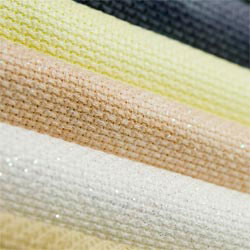Cross Stitch Fabrics
Good needlecraft shops supply a huge, and an often confusing, range of embroidery fabrics. There may be a canvas section, however, this fabric is used for needlepoint and canvas work. For your cross stitch projects, you should look for the section of Aida and evenweave fabrics on which cross stitch is worked.
Cross stitch fabrics are classified either by a thread count number, that is, how many threads or blocks there are to 1 inch (2.5 cm), or by an HPI (holes per inch) number, that is, how many holes there are to 1 inch (2.5 cm). These two terms are the same and will tell you how many cross stitches to 1 inch (2.5 cm) you will work on the fabric. The lower the count, the coarser the fabric and the larger the cross stitch will be. Conversely, the higher the count, the finer the fabric and the smaller the cross stitch will be.
Most cross stitch patterns will either include the fabric in the kit or will advise you which fabric to work on and how much is needed. If, however, the cross stitch pattern gives you no guidance on fabric selection, you should choose cross stitch fabrics that suits your budget, feels good to handle and which has a thread count that is not too hard on your eyes.
Cross Stitch Fabrics:Aida Fabric
Aida fabric is a widely available cotton cross stitch fabrics in which threads are packed together during the weaving process to form blocks. These blocks form easy-to-see squares and each cross stitch is worked over one block. The coarsest is 6 count Binca which is cut into squares mainly for children or beginner cross stitchers. Other Aida fabrics come in various colours and counts – 8, 11, 14, 16 and 18 HPI or blocks to 1 inch (2.5 cm) being the most common.
Some Aida fabrics have Lurex woven in to add sparkle to special occasion cross stitch projects and some, like Rustico, are flecked to give a rustic appearance. Easy-count Aida has a contrasting thread woven into it at regular intervals to assist counting. Once work is completed on easy-count Aida fabric, this contrasting thread is easily removed without disturbing the existing stitches.
Damask fabrics, used for tablecloths and cushions, are available with sections of Aida woven into them at regular intervals. Aida bands or ribbons come in a variety of widths and with plain or decorative edges. When stitched, these have many uses and can decorate a multitude of household items.
Aida can be bought by the metre or often as small off-cuts. It is an ideal cross stitch fabric for beginners, having the advantages of being readily available, relatively inexpensive and the holes are easy to see and count.
Cross Stitch Fabrics: Even-weave Fabric
Even-weave fabric is woven with single threads and is called even-weave because there are the same number of weft (horizontal) threads as there are warp (vertical) threads to 1 inch (2.5 cm). If the cross stitch fabrics is not even-weave, then the design will be distorted as you stitch it and is therefore unsuitable. When using an even-weave fabric, the cross stitch is worked over two threads, so an even-weave with 20 threads to 1 inch (2.5 cm) will produce 10 cross stitches to 1 inch (2.5 cm). There are many thread counts available in even-weave and a large choice of colours.
Common even-weaves are made from cotton only as well as a mix of cotton and viscose. The most luxurious of even-weave cross stitch fabrics is even-weave linen with its excellent qualities of durability and handling.
As even-weave linen is woven from natural fibres, some of the threads are coarser than others, but by working the cross stitch over two threads any discrepancies are evened out.
Hardanger fabric (100% cotton) is also available. This cross stitch fabric has the advantage for beginners of a low thread count, but the appearance of a fine fabric. this is because Hardanger fabrics are double rather than single weave, so the cross stitch is worked over two pairs of threads.
Other Cross Stitch MaterialsThere are a number of other materials that can be used for cross stitch projects. They include:
- plastic canvas, which can be cut and assembled into three-dimensional objects
- perforated paper, for delicate work, can be folded and cut without the edges fraying
- Aida Plus, which is like perforated paper but less fragile
- waste canvas, which can be applied to almost any fabric to make it suitable for cross stitching
- silk gauze, which allows for very fine work in miniature.
So as you can see there is a wide variety of cross stitch fabrics for you to choose from, hopefully this has helped you in making a decision as to which cross stitch fabric is right for your next project.
Recommended Reading
Looking for a good book to read? If your looking for a great reference book to help you out with answers to your cross stitching questions, or maybe your just looking for a present to give that loved one who is mad about cross stitch. Then head over to our books page where we have compiled a list of great books that no serious cross stitcher should be without.
Related Terms:
Cross Stitch Fabric
Cross Stitch Fabrics
Learn more about…
- How to Cross Stitch – General Guidelines
- Cross Stitch Fabrics
- Cross Stitch Thread or Floss
- Calculating How Much Cross Stitch Fabric To Buy
- Cross Stitch Needles
- Cross Stitch Frames and Hoops
- Cross Stitch Charts
- Cross Stitch for Beginners: Securing the edges, finding the centre of the fabric and preparing the thread
- Starting and Finishing a Cross Stitch Pattern
- Working Hem stitch
- Scoring and Stitching a Folded Hem
- Washing and Ironing Cross Stitch
- Stretching and Mounting Cross Stitch
- Framing Cross Stitch


